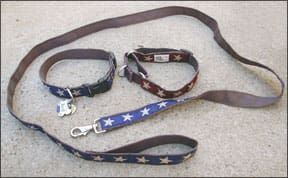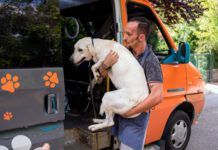Some of my friends have been horrified to learn that my husband and I have chosen, so far, to allow our new dog, Otto, to spend his nights outdoors. From some of our friends’ reactions, you’d think we were turning him loose in the Alaskan wilderness each winter, but the fact is, the decision was made in response to Otto’s own wishes -and our own pressing need for sleep! Allow me to explain.

As I’ve hinted before, Otto is quite nocturnal. Left to his own devices, he would sleep through most of the day, and do his very best to party all night. To his dismay, he’s alone in the wee hours. This is incredibly boring, but he’s game for the challenge of finding things to do, even with so few activity partners at night!
On the few nights when we did try to have him sleep in the house, he paced, whined, chewed stuff up, and nudged me repeatedly (seemingly right after he had gotten a drink of water, and had water all over his beard, every time) as I slept. When we gave him toys and chew-items, he threw them around, clunking them into the walls and furniture. Then he paced and whined some more.
Also, he barked. Because it’s hot where we live, from May through October, and because we aren’t big on air conditioning, we open the house up at night and position fans to bring in cooler air and drive the hot air out of the house. We have screens on the windows, and security screen doors – which means that Otto can hear and see anything that is going on outside at night, but he can’t go investigate. So he barked with his big, booming bark, perhaps as a guarding behavior, but also in frustration. He wanted out.
It didn’t take us long – just a few nearly sleepless nights – to agree that, yes, Otto can go play outside at night. With all the doors and windows open we can still hear when he barks at something -which, thank goodness, is less and less all the time. Because I’m a mom, and have experience with jumping up out of bed to check on a crying baby (albeit 16 years ago . . . these reflexes don’t ever go away, I think), I’m the one who leaps out of bed and goes to the appropriate door to look out and say, “Hey Otto . . . What are you doing?”
Busy, busy, busy
Mostly, what he’s doing is, you know, keeping busy. He looks for random objects to augment his growing toy collection. He collects shoes, tools, and sticks – and of course, anything that we’ve witlessly left untied down – and this fills an hour or two. Tossing those items in the air and carrying them around the yard takes up most of the night.
He chews some things during his nighttime adventures – weird things. He has chewed the arm of a plastic deck chair and the edge of a wooden bench. He loves chewing sticks and scraps from the lumber pile, but his favorite thing to chew is a foam-filled dog bed – yum! He’s chewed up three beds, which I find odd because he also has several soft stuffed toys, and he hasn’t chewed even a tiny hole in any of them.
Due to all the foam-bed-ripping, he’s now down to a single bed, a mat-like fleecy thing that he likes dragging around from the front yard to the backyard and back to the front. He likes to chew stuff up while lying on the mat, but he doesn’t sleep on it. When he does sleep, he either curls up in the dirt or in his (now) bare-floored plastic crate. Go figure.
One good thing that has resulted from his item-chewing and -relocation habits: our yard and deck are now very neat. No one leaves anything out, because we have all learned that anything that’s left outside will be relocated and might be chewed.
The exception to the tidiness is the potting table by our back door; it’s become heaped with a bunch of stuff we don’t want Otto to chew, hide, or roll through the dirt, including shoes, gardening gloves, a paint brush, a broom, Otto’s leash and car harness, his brush, and the toys we want to preserve (or have taken away at night when his tossing them about wakes us up).
As happy as Otto seems to be as a nocturnal dog, we’re trying to convince him that life on the day shift is more fun. Throughout the day, when I see him snoozing in the shade somewhere, I say, “Hey Otto! Wake up!” and engage him in an impromptu training session or race around the house. We give him Kong toys with wet food frozen inside (“Kongsicles”) and rawhide chews or bones to chew on. I invite him into my office, and send him back outside at random intervals. Brian calls him into the house, into his at-home office.

We take him along to the post office – a half block away! We also have been making him exercise a lot. I often take him for an early morning walk or bike ride; we have easy access to some terrific trails where I can let him off-leash and run ahead of my mountain bike. When we walk along the river that runs through our town, he wades and swims a little. About once a week I take him to a dog park for a couple hours of off-leash play with other dogs. And we take him for a long walk or off-leash run every evening. Tiring him out is tiring us out!
“I think it would be easier to put him on a plane and send him to Europe for a week,” I once told Brian. “Maybe he’d come back with jet lag, and get onto our schedule.” I haven’t entirely ruled this out! Still, no matter what we do to try to exhaust him during the day, at around 9 p.m., mellow Otto visibly transforms into Super Otto! His ears and tail go up, and he starts running laps around the house, a toy in his mouth and not a care in the world. It would be darling, except . . .
Oh, the barking!
During his first week with us, Otto barked in short bursts practically all night. He barked when leaves fell onto the deck. He barked when trains went by, as they do about five times a night, about four blocks from our home. He barked when police or ambulance sirens were heard in town, and when a loud truck or motorcycle went by. And of course, he barked when he heard human voices, from people walking by or if he heard loud conversation from any of our neighbors’ homes.
But just at night! During the day, he sleeps through all of it!
Because we got him from our local shelter and his past is unknown, we weren’t sure if previously he had been treated as a watch dog, and perhaps encouraged to bark; had been neglected and allowed to bark; or had lived in a home that was much less stimulating, perhaps in a remote area. What was clear was that he had absolutely no idea that barking at night was not welcome. No matter how excitedly he was barking at something, if I called him, he would turn and run toward me happily.
One of the most basic principles of dog training is that you never, ever, punish or scold or treat in any unhappy way a dog who has come when called, no matter what horrid thing the dog had been doing when you called him. I didn’t want to give him any reason to be reluctant to come to me when I called his name.
Because both of us were sleep-deprived and cranky within three days of Otto’s arrival, on the fourth day, we decided to allow him to stay outside at night. And I volunteered to sleep outside, to be able to call him to me as quickly as possible when he barked. The goal was to interrupt the unwanted behavior – keeping him from practicing something we didn’t want him to do – and to give him something else to do, something we’d rather he do, and to reward him for it. I love to camp and sleep outside anyway, and we have a big, private deck on the side of the house where I could sleep unobserved by the neighbors. And I got a bit more sleep than when Otto was pacing in the house.
Every time Otto barked, I’d whistle or call him as softly as I could, and then pat the foam mattress next to me. He’d joyfully romp back to me and dive onto the bed, rolling over for a belly rub. Sometimes I’d get up and give him a rawhide chew, an interactive toy (he enjoys the plush beehive with the bees that can be pulled out of various openings), or a food-stuffed Kong. Other times, I’d praise him and pet him for a minute, then fall back to sleep.
Within just a couple of nights, Otto stopped barking at all but the most alarming things: people walking by the house in the middle of the night, and cats. I have to admit I’m probably okay with a dog who woofs a time or two when a person is slinking around my house at 3 a.m., though of course I don’t want him barking for longer than that. When I woke to Otto’s barking, and I could see or hear a person or people walking by, I’d let him bark a time or two more, and then call him. “Good boy,” I’d say.
Stray cats: Our nemesis
Cats are another matter. There are a lot of feral cats (and a few wild skunks) that prowl around our riverside town. Prior to Otto’s arrival, at least one of the cats had learned how to enter our cat door and eat our cat’s food in our kitchen. (This was actually a factor in my husband’s sudden decision to get a dog.) Now, with Otto on night patrol, at least one of these cats started hanging out on the sidewalk in front our house, just on the other side of our chain-link fence. Wahoo! Or rather, as Otto puts it, “Wah, woo-woo-woo-woo woo!”
This, I don’t want. If he could chase cats away silently, I’d be all for it, but this is pretty unlikely. When I call him away from a cat, he comes to me, but the second I take my attention from him, he’s amped up to go look for the cat again.
Now, I know from reading 11 years’ worth of articles by Whole Dog Journal’s Training Editor, Pat Miller, that one of the major strategies of a positive training program is to manage the dog’s environment to prevent him from being rewarded for behaviors you don’t want him to repeat. Because we have (weather permitting, for now) allowed him to spend the night outside, we’ve eliminated “putting him in the house” as a viable option to prevent his cat-related barking. And we know he’s busy at night, so I’m not eager to try crating him or locking him in my office; I think he’d freak out.

For now, we’ve settled on a compromise: on most nights, we close the gates on the sides of our house, keeping Otto restricted to the backyard. It’s just a matter of time, I expect, before the feral cats figure this out, and start taunting him from the front yard. To try to prevent that, I sometimes leave a side gate open, so Otto can perform random sweeps of the front yard – usually with a bit of barking, of course.
It’s a work in progress; we know we’ll have to adjust things when the weather starts to get cold. I’m still sleep-deprived, but he’s getting better all the time.
Choosing gear
One of the most rewarding things for me in the past few weeks has been compiling some of my favorite bits of dog-care and -training gear. Like many former horse owners, I’ve got an inordinate love for “tack” – leashes that feel just right in the hand, buckles that adjust easily, training equipment that looks good and fits really well, and so on. Finding the right gear to use with Otto has been fun for me.
One of my first challenges was finding just the right collar. I’ve always put leather collars on my dogs, and especially like those made of soft leather in a full-rolled (round) style. However, Otto has an apparent wealth of experience with ducking out of a collar. He needs a “limited slip” or martingale collar, the kind that tightens when his leash is taut, but one that can’t choke him or tighten too much.
I went back through Whole Dog Journal’s collar reviews, including “The Collar of Money” (May 2005) and “Slip-Sliding Away?” (about martingale collars, in October 2000). I remembered that I liked the limited slip collars made by Premier Pet Products, but preferred the soft hemp fabric and wide variety of colors and styles offered by earthdog (the company doesn’t use capital letters in its name). I looked up the company’s website (earthdog.com) and excitedly ordered a red collar with stars.
This collar has been a dream. It has a nice, big ring on it for clipping a leash onto; I hate hunting one-handed for a too-small ring. It fits nicely, hasn’t allowed Otto to slip loose – even when he was trying hard to escape a bath – looks handsome, and washes well.
Very recently, I was admiring a large line of earthdog collars and leashes in my favorite independent pet supply store (Dog Bone Alley) in my old town of Alameda. I decided that because it had been weeks since Otto had tried to slip his collar, I’d buy a regular earthdog collar, in blue, with a matching leash. We’d be the stars of our next training class!
Back home, I switched the tags from the martingale collar to Otto’s new flat collar, and for days, I admired his new look – until one day I decided he again needed a bath, and he deftly slipped his new collar on the way to the hose. Whoops! Now we change collars frequently; I just have to remember which collar he has on before initiating something he’s likely to try to escape.
Nancy Kerns is Editor of Whole Dog Journal. She adopted Otto from a shelter on June 16, 2008.
earthdog is located in Brentwood, TN. See earthdog.com or call (877) 654-5528.







I love your article and see from the dates of this and other articles that Otto is now a senior. A… I might add….. a very blessed senior. He has an owner who is in tune with him, adjusts his behavior rather than trying to eliminate it. You don’t try to pound the proverbial square peg into the round hole.
I’m curious. Is Otto still so nocturnal? I may have some insight for you. In 2015 and another home, there were 3 dogs living in the woods that edged my block, a mother and two, probably 6 – 12 month old sons. Occasionally I’d see them when they came out to bark at my dogs and me on our daily walks. Other than that, they were rarely seen til dusk, when they came out to scavange in back yards. With golden, flowing coats and feathered tails, I’d see them exit, single file, the safety of the woods at dusk and I began calling them ghost dogs.
Dog rescuer that I fancied myself to be, I decided that I would save them from their plight and with a borrowed trap, succeeded in trapping Charlie. I also got mom but, she escaped before I could get outside. That was it for her and bro.
Charlie just didn’t get the part about having been rescued. My goal was to rehab and rehome him (I already had 3 of my own. Dummy. Sucker. 5 years later he’s very bonded to but one human and tolerates the occasional visits of others, though anything but graciously. I can hug him (please do) and shower him with kisses but still cannot put a collar on him. His is a long story, one I doubt this form has room for or you have patience for. Okay… I think you might be the exception. But I’m straying from the goal of offering insight.
Fast forward to 2020 and Charlie is almost a ‘normal’ dog. If there is one. One habit I’ve noticed is that since adopting the recliner as my bed thanks to back problems, he paces when I first settle in, before settling in for the night. He’s never brought himself to sleep in the same room as I, preferring his old, well chewed, sofa in my bedroom. I fall asleep before my head settles so I’ve never known how long this behavior continues each night. This morning, though, I know. I rose at 3:45 and my hated CPAP monster’s timer said I didn’t have my required 4 hours logged in. Again. This morning I have time, so I settled back in with my hideous contraption to put more time in while I read emails. Cheating at its best. But it also gave me the opportunity to observe Charlie’s behavior, unbeknownst to him. Before my posterior settled in the recliner, he began the ritual. Coincidentally, I found your article when I Googled ‘why does my dog pace when I first go to bed’. I don’t believe in coincidences. It’s what I call, a God thing.
I always thought Charlie was grabbing dog food to munch on in his – my – bedroom. No. He trotted from the bedroom through the dining room and behind the recliner, to the kitchen. Pause 10 seconds and walk back to the bedroom. Thirty seconds later, repeat. Twelve times, I counted, before the cycle slowed between reps and somewhere around twenty (who’s counting by now), it stopped. He went back to his couch and is now laying on his back, zonked to the world.
I am convinced that he patrols to ensure all is well and I…. and he… can safely sleep. Despite all his advances, I think the night will always be a dark and scary place, full of uncertainty and potentially, those monsters who came out to yell and throw things. Perhaps it’s now a compromise – ‘I’ll make sure things are safe before sleeping soundly’. And I suspect that somewhere in his background, Otto lived that life. Perhaps on his own, perhaps confined in a world that yelled and threw things. I suspect that there was a time for him where, like Charlie, your safety seemed to depend on staying awake. All I know for sure is that Otto, like Charlie, are blessed now.
What a sweet story! Thanks for sharing! I think you’re correct, staying alert at night in particular must have been a safety thing. After our first summer together, he got with the program and started sleeping nights (and indoors). He still hates hot weather, though, and still digs into any shady, damp place to rest when it’s hot. His sandbox at our new house has a large patio umbrella covering it.
Our dog has just started staying up all night! She’s a one-year-old Malamute who has full run of the house and our bed if she wants. We never had a problem until this week, she would always sleep right through. In the last few days she’s been waking us up almost hourly from midnight, seemingly just to play or get our attention. Then the scratching at the door starts. We don’t know if its because she needs the toilet so we get up, and no, it’s just to take a look outside and dig in the garden. Then fifteen minutes later it’s scratching at the door from the outside to get back in. We have no idea what’s changed but it’s not to do with health, food or exercise (she gets a lot of running daily). What on earth do we do – I want my sleep back!